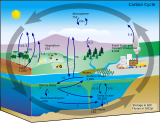
Back Koolstofkringloop Afrikaans دورة الكربون Arabic Ciclu del carbonu AST Karbon dövranı Azerbaijani Кръговрат на въглерода Bulgarian কার্বন চক্র Bengali/Bangla Ciklus ugljika BS Cicle del carboni Catalan Koloběh uhlíku Czech Cylchred carbon Welsh

| Part of a series on the |
| Carbon cycle |
|---|
 |
The carbon cycle is that part of the biogeochemical cycle by which carbon is exchanged among the biosphere, pedosphere, geosphere, hydrosphere, and atmosphere of Earth. Other major biogeochemical cycles include the nitrogen cycle and the water cycle. Carbon is the main component of biological compounds as well as a major component of many rocks such as limestone. The carbon cycle comprises a sequence of events that are key to making Earth capable of sustaining life. It describes the movement of carbon as it is recycled and reused throughout the biosphere, as well as long-term processes of carbon sequestration (storage) to and release from carbon sinks.
To describe the dynamics of the carbon cycle, a distinction can be made between the fast and slow carbon cycle. The fast cycle is also referred to as the biological carbon cycle. Fast cycles can complete within years, moving substances from atmosphere to biosphere, then back to the atmosphere. Slow or geological cycles (also called deep carbon cycle) can take millions of years to complete, moving substances through the Earth's crust between rocks, soil, ocean and atmosphere.[2]
Humans have disturbed the carbon cycle for many centuries. They have done so by modifying land use and by mining and burning carbon from ancient organic remains (coal, petroleum and gas).[1] Carbon dioxide in the atmosphere has increased nearly 52% over pre-industrial levels by 2020, resulting in global warming.[3] The increased carbon dioxide has also caused a reduction in the ocean's pH value and is fundamentally altering marine chemistry.[4] Carbon dioxide is critical for photosynthesis.
- ^ a b Riebeek, Holli (16 June 2011). "The Carbon Cycle". Earth Observatory. NASA. Archived from the original on 5 March 2016. Retrieved 5 April 2018.
- ^ Libes, Susan M (2015). "Blue planet: The role of the oceans in nutrient cycling, maintain the atmosphere system, and modulating climate change". In Smith, Hance D.; Suárez de Vivero, Juan Luis; Agardy, Tundi S. (eds.). Routledge Handbook of Ocean Resources and Management. Routledge. pp. 89–107. ISBN 978-1-136-29482-2.
- ^ "The NOAA Annual Greenhouse Gas Index (AGGI) - An Introduction". NOAA Global Monitoring Laboratory/Earth System Research Laboratories. Retrieved 30 October 2020.
- ^ "What is Ocean Acidification?". National Ocean Service, National Oceanic and Atmospheric Administration. Retrieved 30 October 2020.